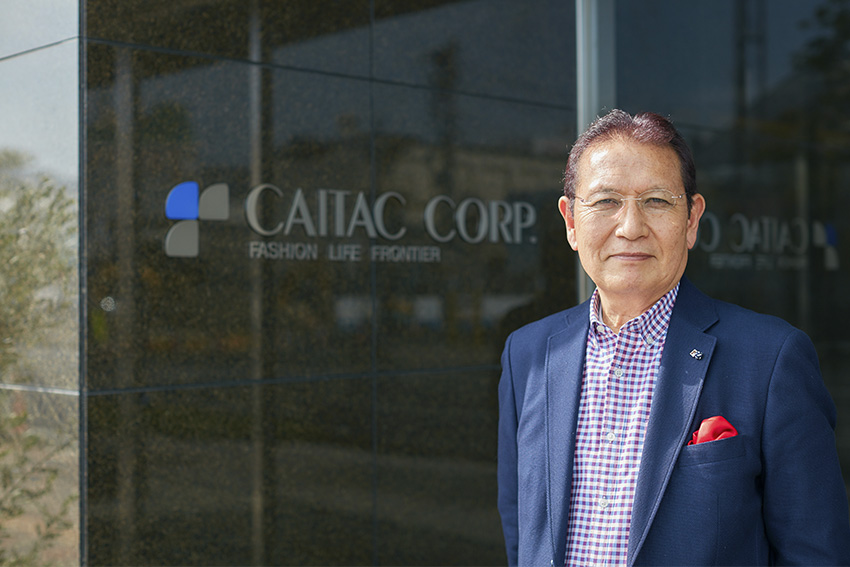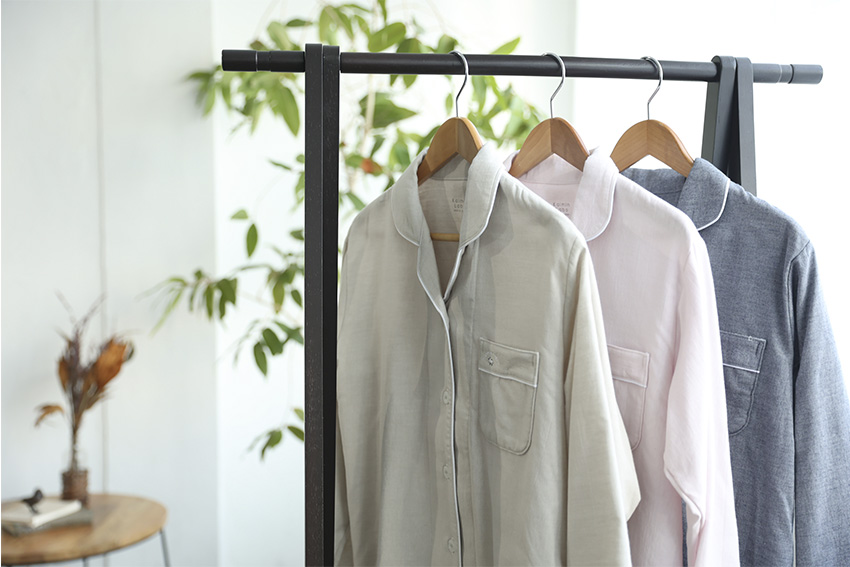Apparel manufacturer Caitac has made responding to customer needs its bread and butter.

Japan has a rich clothing culture. It’s timeless yet evolving. It has modes such as traditional fashion, fast fashion, streetwear, and others, which continue to push the boundaries of style and sophistication. Many designers, such as Issey Miyake, are innovating the spirit of Japan’s renowned cultural heritage for their craftsmanship. Their high-quality takes on designs are increasingly supported by highly integrated automation and a cutting-edge supply chain. How would you define the uniqueness of the Japanese fashion and apparel industry, and what would you say are the main strengths and weaknesses of your industry?
I wouldn’t say that Japanese fashion industry companies are having great success in overseas markets. The only company that is well known is Uniqlo, a fast fashion company that introduced the concept of inexpensive and affordable prices for a mass audience and became a hit. For example, an average piece of clothing that costs USD 100 in the US might only cost USD 15 or 20 at Uniqlo, but this is just one example of the uniqueness and the strength of Japanese apparel companies that went overseas and won the trust and the hearts of customers.
I wouldn’t say that there are many other companies in this industry that have enjoyed success like that, but the blend of tradition, innovation, and introducing authenticity is something that is unique to Japan as a culture and is something that unites all of us.
Japan faces a critical depopulation issue. 29% of the population is over 65, and by 2040, there will be an estimated eleven million worker deficit. This poses the challenge of domestic hiring and sales for many Japanese textile companies needing help to expand internationally. Caitac has a strong presence overseas and strong corporate relationships from which to build. Which strategies do you plan to use for your overseas operations, and are you planning to continue your international expansion? If so, where?
Labor shortage is definitely a big challenge, but I don’t see the problem being solved in next few years. It requires strong vision and leadership in Japanese politics. Taxes are not helping businesses either. Corporate and personal taxes in Japan are high and it is not helping businesses to sustain its personnel. America is different in these scopes.
In Japan, if your annual salary exceeds USD 120,000, for example, then you will have to pay a much higher tax rate. The more money you earn in Japan, the higher your taxes will be. This disparity is also leading to a brain drain, with talented entrepreneurs leaving the country to live and work in Hong Kong and Singapore, which, compared to Japan, are basically tax havens.
Some experts say by 2050, the Japanese economy will collapse. Japanese government plays important role whether Japan will prosper or deteriorate and even possibly become a less developed country.
Related to the population concern is successorship. For smaller companies here in Japan, there’s often nobody to continue the enterprise because there’s not a new generation, so these companies are bought or purchased by a larger company such as yours. In fact, you have done a series of mergers and acquisitions. Last year, you bought three different companies. Could you tell us about those acquisitions in terms of your M&A strategy? What benefits are they bringing to your business?
We are yet evaluating the outcome of recent mergers & acquisitions. Our Pal’las Palace brand was a good example of a successful merger back in the day. However, I may be rather skeptical in M&A in Japan in general. I can only name a few companies that have actually had successful M&A activities.
To discuss the issue of successorship, it’s very hard to do in Japan and Korea, for example, because they have a conglomerate or zaibatsu system. Also, why would you want to take over such companies with all the taxes that are not helping business?
Another issue is R&D, where our people are coming up with bright ideas and technologies from here in Japan or in Korea that are popular, for example, but it’s hard to implement those things because of government regulations. That’s why many companies and entrepreneurs migrate out of Japan.
If we turn to industry trends, we have seen the rise of regional manufacturing competitors like Korea, China, and Taiwan that have replicated the Japanese model of success. This has resulted in diminished returns for Japanese firms internationally, yet some Japanese B2B or B2C textile brands, such as Uniqlo and Yagi Tsusho, have seen success in overseas markets. What added value do Japanese textile brands bring to their customers?
Denim is all about washing and garment processing techniques. It’s a very crucial component, and we are the ones who tried to introduce it to America. Now, we are actually the biggest washing factory in America. The reason I’m emphasizing this is that if you’re not introducing washing and processing techniques, then you won’t be able to sell this product successfully, so we have tried to sustain this as much as possible. And that illustrates the devotion to technology and the traditional ways of making denim, which is a good thing about Japanese companies.
There are three major fast fashion companies in the world: Uniqlo, Zara, and H&M. Zara and H&M are European brands. They know about fashion, and they know how to make a good product for customers. Uniqlo has a different strategy because they focus on a rather low price but definitely high quality, so their production lines focus on particular pieces and produce them in higher quantities to reduce the cost and final selling price. The in-store experience is good, whether it be the staff, the purchase experience, or the store design. It’s very neat and cute. So, that’s something that relates to Japanese business practices for attracting customers.
What strategies or innovations are you implementing to be ahead of the overseas competition?
Employing the best employees is very important, regardless of how much money it will cost.
I’m curious about your YANUK denim brand because true denim aficionados appreciate Japanese quality. If you look at Momotaro, Visvim, Studio D’Artisan, and other Japanese brands, they are very successful overseas. The quality is high, and so is the price. I think it’s the same with your YANUK brand, which you launched in 2003. It is kind of an L.A.-inspired brand that uses very high-quality materials. You also create very lightweight denim options. Can you tell us how you’ve been so successful with that brand?
The reason YANUK became successful is that we didn’t do the traditional sales activities that many garment related companies in Japan do, which is to sell to the wholesale companies. We tried that at first and weren’t successful, so we opened our own stores and ran the business by ourselves. That was the reason we found success, because we put our efforts into that direct retail store rather than going through trade houses.
Another reason for YANUK’s success is our quick response manufacturing. We respond to the market quickly because we are a domestic manufacturing company as well. There are department store chains like Daiei or Ito Yokado that sell clothing, often from Southeast Asia companies. From production until sales in Japan, it takes roughly half a year to reach the shelves of these stores. On the other hand, we can make products quickly knowing that the products are selling good in our own stores. The same is true in the US. If you go to the traders or the department stores, as long as they like your products and you can sell through them, it’s the way to go. But Japan is a slightly different story. It’s very difficult to succeed in wholesale companies.

YANUK jeans
We took quick response inspiration from Toyota’s production systems and philosophy. For example, Toyota has the same principles of selling by themselves. All their sales are via franchise dealerships that they control. It is very different from other automobile makers. Toyota’s success is outstanding and we realized that you have to control sales yourself.
There was a story with the American company called J. C. Penney. Their business became less successful because they tried to use cheaper overseas labor but they lost a big part of their customer base in the US because of the delays the new, less expensive supply chain caused. In the end, quality speaks for itself, and time is money. You can pay more to get a good product in a short period, or you can go for cheaper replicants and wait longer.
Could you tell us more about Kaimin Labo, another brand you have?
Unfortunately, I cannot say that the quick response of YANUK was adopted as well as I would have liked with Kaimin Labo and that it’s a great success right now. I mean, Kaimin Labo has yet to find the success that YANUK has. Kaimin Labo is a pajama brand, and perhaps it can find wider acceptance in America rather than Japan. I can definitely see that happening in the future. Many customers are avoiding the product because there’s a little less variation in the sizes. Pajamas come with S, M, and L sizing. The reason I say that perhaps America could be a good market for Kaimin Labo is because the average height of people there is very high. There are no pajama options in big sizes, so maybe we can offer that as a new market approach.

Kaimin Labo pajamas
We could target nursing homes or hospitals because pajamas are something that is regularly worn there. Across the nation and the globe, pajamas are something that is only sometimes worn. Some people wear a T-shirt and shorts or something like that, so pajamas may need to be properly introduced to become more accepted, but mostly, we will look at niche markets. Ultimately, it’s a luxury product, so it will mostly appeal to people who have money for it. It’s also a product that is a bit difficult to care for. It’s best to air dry or iron, so not everyone will want something that requires so much effort.
As for the product itself, we are introducing a new fabric, which doesn’t look special, like woven twill, but it is not woven fabric. It is knitted. The look is not special, but when you put it on, it’s very comfortable. The knit fabric offers a natural give in 360 degrees, as opposed to woven fabric, which may stretch in two ways but not 360 degrees. It also doesn’t shrink or change shape when washed, and you don’t need to iron it because it doesn’t wrinkle.
Everything is made to order, and that’s why we think it may be more applicable to the US market. We can accommodate more sizes and preferences, and about 90% of the products use our new fabric. Our production capacity is about 600,000 pieces annually. It is difficult to balance production with made-to-order products, especially since fewer people want made-to-order pajamas. Pricing is another issue. The average retail price for pajamas would normally be about JPY 4,000, whereas if they are made to order, they will be more like JPY 25,000, so we need to find a market willing to pay those prices to sustain production. We’ve been trying to find success for ten years, but it’s very difficult because the average consumer in Japan cannot afford luxury pajamas and doesn’t go to stores to buy them.
To get it to market, what kinds of retail chains are you looking to partner with or what’s the process to increase the sales in the US?
E-commerce is the primary channel we are pursuing and we are targeting people that can’t really wear the standard S, M, and L sizes.
You have some notable brand subsidiaries. For example, Okayama Denim, known for its indigo hues and quality craftsmanship. On your online retail platform, denim connoisseurs and fashion-savvy people can access your products from all over the world. You also have other brands. Could you tell us which new or upcoming subsidiaries, products, or services you’re interested in bringing to the international market?
Currently, we have two brands with the same stretchy new fabric. The backstory is that in 1991, we first started operations in L.A. That wasn’t actually our own brand. We worked with a local company to provide washing and garment processing services. After ten years of collaboration, we started working by ourselves. We now have a split between men’s and women’s brands. The women’s brand is called elims, which is the word smile spelled backward. It is still in its early stages. The men’s brand is called KATO, and it has been selling successfully in the high-end US retail store chain Nordstrom and online. We had sales of USD 8.8 million in the last fiscal year, and a lot of that is driven by social media since we have over 100,000 Instagram followers.
KATO was originally a Japanese brand but now it is more popular in the US. We will continue to introduce our own brands to the US. They could be brands we bring over from Japan or ones we start new. elims was born in L.A. and if it is successful in the US, we will introduce it to Japan.
Tell us a little more about YANUK. Is it more popular domestically or internationally?
YANUK is popular in Japan but not in the US or overseas. That could be an opportunity for us. Our focus is domestic for now. We were originally wholesale-driven, but now are focusing on retail stores, of which we have over twenty, and of course, e-commerce as well. That’s possibly an overseas opportunity in the coming years, but in order to do so, we have to be successful with our L.A. company and its other brands.
Sustainability is a big issue in your industry. What efforts are you making to address this issue?
Many companies talk about their commitment to Sustainable Development Goals (SDGs). It’s an activity where the company has to come up with policies driven by the government. Honestly, with many companies, it’s just greenwashing, not real action. In some ways, it’s like the combustion engine vs. electric vehicles. Everybody says EVs will be the future, but it’s not that likely in Japan. For example, gasoline is heavily taxed, and that revenue is used to build and maintain roads and other infrastructure, but what happens if you switch to EVs and there is no gasoline tax revenue? Incentives are also something that must be considered in transitioning to eco-friendly vehicles, but in the end, maybe that’s not the ultimate solution.
Speaking about SDGs and our company, we have operations in California and we are the largest manufacturing factory in the United States. We have over 200 employees and a big factory. Sustainable activities are important to create a circular economy and cost is something we have to overcome and is still a bit unknown, but we continue to take that challenge.
We believe that quick response (QR) manufacturing is one solution to the circular economy because it’s impossible to predict what’s going to sell six months in the future, but the current global supply chain forces every player to predict six months ahead. As a result, there is a lot of unsold inventory that is never even worn but goes to a landfill. Or it sold great, and everyone was excited, but the supply ran out, and if we placed a new order, we had to wait for six months. So QR is a solution because we limit and reduce waste and avoid making excess products. In our operations, we are highly focused on QR, and via e-commerce, we monitor what is selling or not selling. When we see products selling, we produce them, but if they are not selling, we change the marketing or do other things. but in the end, if it’s not selling, we don’t make the product, and we have very limited or even no inventory.
Besides QR, in our US factory, we are going into solar power and water recycling because making jeans and garment processing uses a lot of energy, water, and chemicals. We are installing solar panels on the roof and making a water recycling plant, so ultimately, 90% of our electricity demand will be met by solar, and 75-85% of the water that we use will be recycled and put back into the production line.
Ultimately, SDGs are a big challenge, but we are trying to meet that challenge, and if the water recycling goes well in the US, then we will do the same thing in Japan. Right now, it is under construction, but it’s expected to be online sometime this year. So, QR, sustainability in terms of energy and water, and circular manufacturing are few approaches we are taking as a group company.
If we were to come back to interview you again in the future, on your last day as the Chairman and CEO of the CAITAC GROUP, what would you like to have achieved by then?
My ambition and goal as the chairman of the company is to change the more traditional ways of doing things. We are currently a B2B wholesale driven company. It would be ideal to grow B2C retail businesses including online direct sales, while we continue to be successful with B2B wholesale businesses. Our mission is to make a shift and become a successful B2B and B2C company.
For more information, visit their website at: https://www.caitac.co.jp/
0 COMMENTS